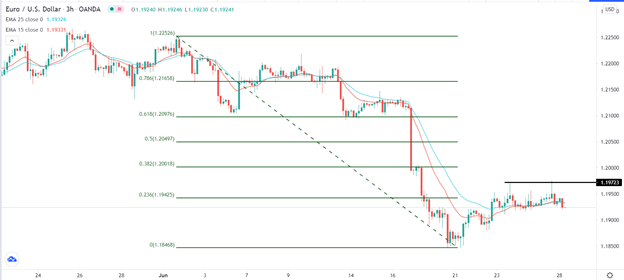Bearish View
- Sell the EUR/USD and add a take-profit at 1.1850.
- Add a stop-loss at 1.1970.
- Timeline: 1-2 days.
Bullish View
- Set a buy-stop at 1.1945 and a take-profit at 1.2000.
- Add a stop-loss at 1.1850.
The EUR/USD declined after the strong US personal consumption expenditure (PCE) data and as hopes of an infrastructure package rose. The pair is trading at 1.1924, which was slightly below last week’s high of 1.1975.
US Infrastructure
The US economic growth is set to accelerate as the country deliberates on the new infrastructure package. Last week, a group of bipartisan senators reached a deal that will see the government fund new infrastructure projects worth almost $1 trillion. The funds will go towards building and upgrading roads and bridges a transit network and airports. The investments will add to the US debt, which is approaching $30 trillion.
The EUR/USD is also reacting to the relatively strong US inflation data. On Friday, data by the country’s statistics agency showed that the personal consumer expenses (PCE) data rose by 0.4% in March. This was the third straight monthly increase and was above the median estimate of 0.5%. The PCE rose by 3.9% on a year-on-year basis. The biggest increase since 2008 when oil prices were at $150. The PCE is the Fed’s favorite measure of inflation.
At the same time, the number of unemployment benefit recipients has continued to drop. According to the Wall Street Journal, the progress has been better in states that started cancelling enhanced and extended benefits this month. This is a sign that some Americans are not working because unemployment benefits are better than their salaries.
Looking ahead, the EUR/USD will today react mildly to the latest German Import Price Index and Swedish retail sales numbers. Analysts expect that the German Import Price Index rose by 1.4% in May, leading to year-on-year growth of 11.3%. On Tuesday, the pair will react to the latest Eurozone business and consumer confidence data.
EUR/USD Technical Analysis
The three-hour chart shows that the EUR/USD pair formed a double-top pattern at 1.1972 last week. In price action, a double-top is usually a bearish signal. The pair also dropped below the 25-day and 15-day moving averages. It is currently approaching the neckline of the double-top pattern. Also, it has moved below the 23.6% Fibonacci retracement level. Therefore, the pair may maintain the downward trend as investors target this month’s low at 1.1846. On the flip side, a move above the double-top will see the pair rise to the next psychological level at 1.2000.


